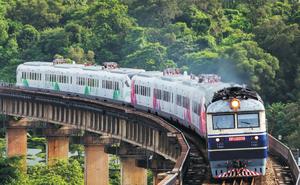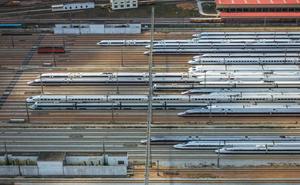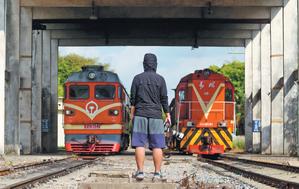Photographer who snaps locomotives hopes that his hobby will provide a platform for a future career, Li Yingxue reports.
 A selection of pictures of trains and the stunning locations through which they travel in Zhaoqing and Qingyuan, Guangdong province, as taken by train enthusiast Guan Junhong, 22. (PHOTO PROVIDED TO CHINA DAILY)
A selection of pictures of trains and the stunning locations through which they travel in Zhaoqing and Qingyuan, Guangdong province, as taken by train enthusiast Guan Junhong, 22. (PHOTO PROVIDED TO CHINA DAILY)
It is a train of events, literally, that has changed his life. Traveling on them, taking photos and discussing the latest information about them is an indispensable part of Guan Junhong's existence. Their arrivals and departures are the timetable around which his life revolves.
Whenever the junior student at Dongguan University of Technology in Guangdong province has time, he plots a journey and hops on a train, always with his trusted camera. The more time he has, the further he goes.
For the past seven years, the 22-year-old has taken trains to travel across China, racking up 70,000 kilometers and over 100,000 photos of trains.
He can identify different types of locomotive at a distance with just a brief glimpse and by the sound it makes on the tracks.
Guan has a map in his head showing all the major railways in China, and his goal is to record every model of locomotive in the country with his lens.
In 2004, the then 6-year-old was taken to the local locomotive depot near his home in Shaoguan, Guangdong province, by his grandfather when they went out for a walk. He still remembers the engines he saw that day-some painted green, some painted red and others painted blue.
Years later when he started to learn more about trains, he learned that the blue ones were the China Railway SS8, the fastest train at the time, capable of traveling at 240 kilometers per hour in 1998.
 A selection of pictures of trains and the stunning locations through which they travel in Zhaoqing and Qingyuan, Guangdong province, as taken by train enthusiast Guan Junhong, 22. (PHOTO PROVIDED TO CHINA DAILY)
A selection of pictures of trains and the stunning locations through which they travel in Zhaoqing and Qingyuan, Guangdong province, as taken by train enthusiast Guan Junhong, 22. (PHOTO PROVIDED TO CHINA DAILY)
"I thought buses were cool when I was a boy-but when I saw trains for the first time, they really impressed me," Guan says.
In 2010, when the Wuhan-Guangzhou high-speed railway had just opened, Guan's parents took him on the high-speed train from Shaoguan to Guangzhou, provincial capital of Guangdong province.
"It was the first time that I took a high-speed train, and it looked like a bullet which was cool. The carriage was clean and cozy," Guan says. "What amazed me was that it only took 40 minutes, while the regular train took two and a half hours."
During high school, Guan started to collect information about trains, and around the same time he was given his first camera by his parents. "My high school was next to the Beijing-Guangzhou railway, so I started to take photos of the trains passing by," he recalls.
In 2013, he revisited the Shaoguan locomotive depot with his camera and found that it had turned into a workshop, but the green and red engines were still there. Both had finished their service and been replaced by more advanced models.
At the end of that summer vacation, Guan visited the place again to photograph the trains before they were disassembled.
"The workers tore apart the trains so quickly and adeptly that one was reduced to small pieces in just half an hour," he says.
 Another of his many images, captured over a period of seven years, shows trains housed at the Guangzhou South high-speed rail depot. (PHOTO PROVIDED TO CHINA DAILY)
Another of his many images, captured over a period of seven years, shows trains housed at the Guangzhou South high-speed rail depot. (PHOTO PROVIDED TO CHINA DAILY)
Pulling together
Guan likes to "follow the trains" with other enthusiasts-or trainspotters as they are referred to in parts of the West-and they communicate via dedicated WeChat groups.
Feng Jiaxi, a 15-year-old high school student in Guangzhou who started to take photos of trains in 2015, is in the same WeChat group as Guan.
"People who like to take photos of trains often meet at the railway station," Jiaxi explains. "When a train pulls in, you can easily tell who are the train enthusiasts as they start snapping away with their cameras."
Trains are given nicknames by these enthusiasts. The Yellow Doctor, for instance, is a train that examines and tests the track before the scheduled passenger services.
"In the WeChat group, we share information as well as all the photos we take and I will ask questions in the group if there is information about a train that I can't find on the internet," Jiaxi says.
In July, Jiaxi, Guan and another friend took a two-day train trip from Guangzhou to Zhanjiang in Guangdong province. "There are railways on the seaside, which are pretty to record, and I enjoy the feeling when a train passes by," he says. "During the trip, Guan was very kind and took good care of me."
On May 11, 2018, the first day of the Guangzhou-Hong Kong high-speed railway test run, Guan missed the new train, most commonly referred to as the "Vibrant Express", to the Guangzhou South Railway Station.
He and another trainspotter later found a tall building about a kilometer away from the station, where they found a good vantage point to take photos. They could also clearly hear the toots, whistles and the whine of the train's engine.
The next day, he was finally able to train his lens on the Vibrant Express departing from the station. "I like to take photos of models like the Vibrant Express. The design is interesting, and it's very colorful," Guan says.
 Guan, a junior student at Dongguan University of Technology, examines two classic engines at a locomotive depot in Zhanjiang, Guangdong, in July 2020. (PHOTO PROVIDED TO CHINA DAILY)
Guan, a junior student at Dongguan University of Technology, examines two classic engines at a locomotive depot in Zhanjiang, Guangdong, in July 2020. (PHOTO PROVIDED TO CHINA DAILY)
Tracking the changes
Trainspotters are united by their love of trains but they may have different aspects of interest. Some like to take photos, some are interested in timetables and some like to study the technical side.
Guan likes to take photos of trains passing through various landscapes, such as mountains, over and under bridges, and along the banks of reservoirs.
Guan has noticed the changes his camera has recorded. Not only are the trains themselves updated and upgraded, but also the cities that the trains pass through have changed.
"Take the high-speed railway from Shaoguan to Guangzhou as an example. Ten years ago when I first took a trip on the line, there was uncultivated land everywhere, which has now turned into cropland for sugarcane or rice," Guan says.
He also says that the area around the high-speed railway station has been under rapid development with real estate projects and industrial parks springing up in the space of just a few years.
The environment differs across the country, so trains in different regions have diverse styles.
Most of the trains Guan has taken photos of run in Guangdong province, so he says he hopes that someday he can capture images of trains all across the country.
As for the train models that are no longer in service, Guan can only see them in the museums, but when new trains are about to come into service, he is sometimes invited by the train companies, as a specialist photographer, to have a look beforehand.
He also started taking photos of the metros in Dongguan when he studied at the university there.
Guan chose the major of town and country planning, because he wants to take part in designing the metro network for his hometown after graduation.
"Taking photos of trains is still a niche hobby," Guan says. "People may think that nothing worthy comes from taking photos of trains, but I think otherwise. I think it's pretty cool to see the trains crossing mountains or speeding alongside rivers."
Contact the writer at liyingxue@chinadaily.com.cn


